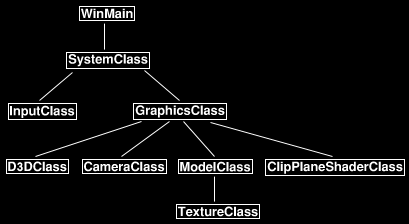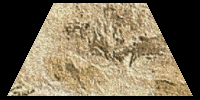DirectX10 教程24:剪裁平面
原文地址:Tutorial 24: Clipping Planes(http://www.rastertek.com/dx10tut24.html)。
源代码下载:dx10tut24.zip。
本教程介绍如何使用HLSL和C++实现剪裁平面,代码基于上一个教程。
剪裁平面通常用于在3D空间中截取几何体。多数人最熟悉的例子就是创建视锥体时设置的近裁和远裁平面。视场的远裁平面会剔除任何超出它的范围的几何体,这样我们就不会绘制3D场景中的所有对象。
用过以前版本DirectX的人会发现在DirectX 10中实现剪裁平面的方法有所不同。以前是创建一个平面对象,然后用设备的SetRenderState设置剪裁平面,而在DirectX 10中是在像素着色器的输入结构体中使用SV_ClipDistance语义达到同样的效果。
本教程我们会学习如何创建剪裁平面剔除场景中的几何体,剪裁平面与绘制到纹理这两种技术的组合可以在以后的教程中生成更为强大的效果。
框架
框架中新添了ClipPlaneShaderClass,这个类只是TextureShaderClass的改编版本。

Clipplane.fx
clip plane HLSL文件只是基本的texture shader文件的改编版本,添加了处理剪裁平面的插值。
//////////////////////////////////////////////////////////////////////////////// // Filename: clipplane.fx //////////////////////////////////////////////////////////////////////////////// ///////////// // GLOBALS // ///////////// matrix worldMatrix; matrix viewMatrix; matrix projectionMatrix; Texture2D shaderTexture;
新添了一个float4类型的clipP变量,我们可以设置这个变量确定剪裁平面的朝向和哪些部分会被剪裁。前三个浮点数定义了剪裁平面的法线方向,第四个浮点数表示剪裁的位置。例如,(0.0f, 1.0f, 0.0f, -5.0f)表示Y轴之下5个单位以下的部分都会被剪裁而不被绘制。本教程使用的值是(0.0f, -1.0f, 0.0f, 0.0f),即Y坐标大于0的部分会被剪裁。
float4 clipPlane;
///////////////////
// SAMPLE STATES //
///////////////////
SamplerState SampleType
{
Filter = MIN_MAG_MIP_LINEAR;
AddressU = Wrap;
AddressV = Wrap;
};
//////////////
// TYPEDEFS //
//////////////
struct VertexInputType
{
float4 position : POSITION;
float2 tex : TEXCOORD0;
};
struct PixelInputType
{
float4 position : SV_POSITION;
float2 tex : TEXCOORD0;
clip plane语义需要被传递到像素着色器。
float clip : SV_ClipDistance0;
};
////////////////////////////////////////////////////////////////////////////////
// Vertex Shader
////////////////////////////////////////////////////////////////////////////////
PixelInputType ClipPlaneVertexShader(VertexInputType input)
{
PixelInputType output;
// Change the position vector to be 4 units for proper matrix calculations.
input.position.w = 1.0f;
// Calculate the position of the vertex against the world, view, and projection matrices.
output.position = mul(input.position, worldMatrix);
output.position = mul(output.position, viewMatrix);
output.position = mul(output.position, projectionMatrix);
// Store the texture coordinates for the pixel shader.
output.tex = input.tex;
要为像素着色器建立剪裁平面,只需用世界空间中的顶点点乘剪裁平面即可,这样像素着色器就不会绘制被剪裁平面剔除的像素了。
// Set the clipping plane.
output.clip = dot(mul(input.position, worldMatrix), clipPlane);
return output;
}
////////////////////////////////////////////////////////////////////////////////
// Pixel Shader
////////////////////////////////////////////////////////////////////////////////
float4 ClipPlanePixelShader(PixelInputType input) : SV_Target
{
return shaderTexture.Sample(SampleType, input.tex);
}
////////////////////////////////////////////////////////////////////////////////
// Technique
////////////////////////////////////////////////////////////////////////////////
technique10 ClipPlaneTechnique
{
pass pass0
{
SetVertexShader(CompileShader(vs_4_0, ClipPlaneVertexShader()));
SetPixelShader(CompileShader(ps_4_0, ClipPlanePixelShader()));
SetGeometryShader(NULL);
}
}
Clipplaneshaderclass.h
ClipPlaneShaderClass只是在TextureShaderClass基础上添加了处理剪裁的代码。
////////////////////////////////////////////////////////////////////////////////
// Filename: clipplaneshaderclass.h
////////////////////////////////////////////////////////////////////////////////
#ifndef _CLIPPLANESHADERCLASS_H_
#define _CLIPPLANESHADERCLASS_H_
//////////////
// INCLUDES //
//////////////
#include <d3d10.h>
#include <d3dx10.h>
#include <fstream>
using namespace std;
////////////////////////////////////////////////////////////////////////////////
// Class name: ClipPlaneShaderClass
////////////////////////////////////////////////////////////////////////////////
class ClipPlaneShaderClass
{
public:
ClipPlaneShaderClass();
ClipPlaneShaderClass(const ClipPlaneShaderClass&);
~ClipPlaneShaderClass();
bool Initialize(ID3D10Device*, HWND);
void Shutdown();
void Render(ID3D10Device*, int, D3DXMATRIX, D3DXMATRIX, D3DXMATRIX, ID3D10ShaderResourceView*, D3DXVECTOR4);
private:
bool InitializeShader(ID3D10Device*, HWND, WCHAR*);
void ShutdownShader();
void OutputShaderErrorMessage(ID3D10Blob*, HWND, WCHAR*);
void SetShaderParameters(D3DXMATRIX, D3DXMATRIX, D3DXMATRIX, ID3D10ShaderResourceView*, D3DXVECTOR4);
void RenderShader(ID3D10Device*, int);
private:
ID3D10Effect* m_effect;
ID3D10EffectTechnique* m_technique;
ID3D10InputLayout* m_layout;
ID3D10EffectMatrixVariable* m_worldMatrixPtr;
ID3D10EffectMatrixVariable* m_viewMatrixPtr;
ID3D10EffectMatrixVariable* m_projectionMatrixPtr;
ID3D10EffectShaderResourceVariable* m_texturePtr;
新添了指向shader中的clip plane矢量的指针。
ID3D10EffectVectorVariable* clipPlanePtr; }; #endif
Clipplaneshaderclass.cpp
////////////////////////////////////////////////////////////////////////////////
// Filename: clipplaneshaderclass.cpp
////////////////////////////////////////////////////////////////////////////////
#include "clipplaneshaderclass.h"
ClipPlaneShaderClass::ClipPlaneShaderClass()
{
m_effect = 0;
m_technique = 0;
m_layout = 0;
m_worldMatrixPtr = 0;
m_viewMatrixPtr = 0;
m_projectionMatrixPtr = 0;
m_texturePtr = 0;
clipPlanePtr = 0;
}
ClipPlaneShaderClass::ClipPlaneShaderClass(const ClipPlaneShaderClass& other)
{
}
ClipPlaneShaderClass::~ClipPlaneShaderClass()
{
}
bool ClipPlaneShaderClass::Initialize(ID3D10Device* device, HWND hwnd)
{
bool result;
加载clip plane HLSL文件。
// Initialize the shader that will be used to draw the triangles.
result = InitializeShader(device, hwnd, L"../Engine/clipplane.fx");
if(!result)
{
return false;
}
return true;
}
void ClipPlaneShaderClass::Shutdown()
{
// Shutdown the shader effect.
ShutdownShader();
return;
}
Render方法的参数有一个是float4矢量clip plane,它会在绘制之前设置到shader中。
void ClipPlaneShaderClass::Render(ID3D10Device* device, int indexCount, D3DXMATRIX worldMatrix, D3DXMATRIX viewMatrix,
D3DXMATRIX projectionMatrix, ID3D10ShaderResourceView* texture, D3DXVECTOR4 clipPlane)
{
// Set the shader parameters that it will use for rendering.
SetShaderParameters(worldMatrix, viewMatrix, projectionMatrix, texture, clipPlane);
// Now render the prepared buffers with the shader.
RenderShader(device, indexCount);
return;
}
bool ClipPlaneShaderClass::InitializeShader(ID3D10Device* device, HWND hwnd, WCHAR* filename)
{
HRESULT result;
ID3D10Blob* errorMessage;
D3D10_INPUT_ELEMENT_DESC polygonLayout[2];
unsigned int numElements;
D3D10_PASS_DESC passDesc;
// Initialize the error message.
errorMessage = 0;
// Load the shader in from the file.
result = D3DX10CreateEffectFromFile(filename, NULL, NULL, "fx_4_0", D3D10_SHADER_ENABLE_STRICTNESS, 0,
device, NULL, NULL, &m_effect, &errorMessage, NULL);
if(FAILED(result))
{
// If the shader failed to compile it should have writen something to the error message.
if(errorMessage)
{
OutputShaderErrorMessage(errorMessage, hwnd, filename);
}
// If there was nothing in the error message then it simply could not find the shader file itself.
else
{
MessageBox(hwnd, filename, L"Missing Shader File", MB_OK);
}
return false;
}
Technique名称修改为ClipPlaneTechnique。
// Get a pointer to the technique inside the shader.
m_technique = m_effect->GetTechniqueByName("ClipPlaneTechnique");
if(!m_technique)
{
return false;
}
// Now setup the layout of the data that goes into the shader.
// This setup needs to match the VertexType stucture in the ModelClass and in the shader.
polygonLayout[0].SemanticName = "POSITION";
polygonLayout[0].SemanticIndex = 0;
polygonLayout[0].Format = DXGI_FORMAT_R32G32B32_FLOAT;
polygonLayout[0].InputSlot = 0;
polygonLayout[0].AlignedByteOffset = 0;
polygonLayout[0].InputSlotClass = D3D10_INPUT_PER_VERTEX_DATA;
polygonLayout[0].InstanceDataStepRate = 0;
polygonLayout[1].SemanticName = "TEXCOORD";
polygonLayout[1].SemanticIndex = 0;
polygonLayout[1].Format = DXGI_FORMAT_R32G32_FLOAT;
polygonLayout[1].InputSlot = 0;
polygonLayout[1].AlignedByteOffset = D3D10_APPEND_ALIGNED_ELEMENT;
polygonLayout[1].InputSlotClass = D3D10_INPUT_PER_VERTEX_DATA;
polygonLayout[1].InstanceDataStepRate = 0;
// Get a count of the elements in the layout.
numElements = sizeof(polygonLayout) / sizeof(polygonLayout[0]);
// Get the description of the first pass described in the shader technique.
m_technique->GetPassByIndex(0)->GetDesc(&passDesc);
// Create the input layout.
result = device->CreateInputLayout(polygonLayout, numElements, passDesc.pIAInputSignature, passDesc.IAInputSignatureSize,
&m_layout);
if(FAILED(result))
{
return false;
}
// Get pointers to the three matrices inside the shader so we can update them from this class.
m_worldMatrixPtr = m_effect->GetVariableByName("worldMatrix")->AsMatrix();
m_viewMatrixPtr = m_effect->GetVariableByName("viewMatrix")->AsMatrix();
m_projectionMatrixPtr = m_effect->GetVariableByName("projectionMatrix")->AsMatrix();
// Get pointer to the texture resource inside the shader.
m_texturePtr = m_effect->GetVariableByName("shaderTexture")->AsShaderResource();
获取指向shader中的clip plane变量的接口。
// Get a pointer to the clip plane inside the shader.
clipPlanePtr = m_effect->GetVariableByName("clipPlane")->AsVector();
return true;
}
void ClipPlaneShaderClass::ShutdownShader()
{
// Release the clip plane pointer.
clipPlanePtr = 0;
// Release the pointer to the texture in the shader file.
m_texturePtr = 0;
// Release the pointers to the matrices inside the shader.
m_worldMatrixPtr = 0;
m_viewMatrixPtr = 0;
m_projectionMatrixPtr = 0;
// Release the pointer to the shader layout.
if(m_layout)
{
m_layout->Release();
m_layout = 0;
}
// Release the pointer to the shader technique.
m_technique = 0;
// Release the pointer to the shader.
if(m_effect)
{
m_effect->Release();
m_effect = 0;
}
return;
}
void ClipPlaneShaderClass::OutputShaderErrorMessage(ID3D10Blob* errorMessage, HWND hwnd, WCHAR* shaderFilename)
{
char* compileErrors;
unsigned long bufferSize, i;
ofstream fout;
// Get a pointer to the error message text buffer.
compileErrors = (char*)(errorMessage->GetBufferPointer());
// Get the length of the message.
bufferSize = errorMessage->GetBufferSize();
// Open a file to write the error message to.
fout.open("shader-error.txt");
// Write out the error message.
for(i=0; i<bufferSize; i++)
{
fout << compileErrors[i];
}
// Close the file.
fout.close();
// Release the error message.
errorMessage->Release();
errorMessage = 0;
// Pop a message up on the screen to notify the user to check the text file for compile errors.
MessageBox(hwnd, L"Error compiling shader. Check shader-error.txt for message.", shaderFilename, MB_OK);
return;
}
void ClipPlaneShaderClass::SetShaderParameters(D3DXMATRIX worldMatrix, D3DXMATRIX viewMatrix, D3DXMATRIX projectionMatrix,
ID3D10ShaderResourceView* texture, D3DXVECTOR4 clipPlane)
{
// Set the world matrix variable inside the shader.
m_worldMatrixPtr->SetMatrix((float*)&worldMatrix);
// Set the view matrix variable inside the shader.
m_viewMatrixPtr->SetMatrix((float*)&viewMatrix);
// Set the projection matrix variable inside the shader.
m_projectionMatrixPtr->SetMatrix((float*)&projectionMatrix);
// Bind the texture.
m_texturePtr->SetResource(texture);
设置shader中的clip plane矢量。
// Set the clip plane inside the shader.
clipPlanePtr->SetFloatVector((float*)&clipPlane);
return;
}
void ClipPlaneShaderClass::RenderShader(ID3D10Device* device, int indexCount)
{
D3D10_TECHNIQUE_DESC techniqueDesc;
unsigned int i;
// Set the input layout.
device->IASetInputLayout(m_layout);
// Get the description structure of the technique from inside the shader so it can be used for rendering.
m_technique->GetDesc(&techniqueDesc);
// Go through each pass in the technique (should be just one currently) and render the triangles.
for(i=0; i<techniqueDesc.Passes; ++i)
{
m_technique->GetPassByIndex(i)->Apply(0);
device->DrawIndexed(indexCount, 0, 0);
}
return;
}
Graphicsclass.h
////////////////////////////////////////////////////////////////////////////////
// Filename: graphicsclass.h
////////////////////////////////////////////////////////////////////////////////
#ifndef _GRAPHICSCLASS_H_
#define _GRAPHICSCLASS_H_
/////////////
// GLOBALS //
/////////////
const bool FULL_SCREEN = true;
const bool VSYNC_ENABLED = true;
const float SCREEN_DEPTH = 1000.0f;
const float SCREEN_NEAR = 0.1f;
///////////////////////
// MY CLASS INCLUDES //
///////////////////////
#include "d3dclass.h"
#include "cameraclass.h"
#include "modelclass.h"
#include "clipplaneshaderclass.h"
////////////////////////////////////////////////////////////////////////////////
// Class name: GraphicsClass
////////////////////////////////////////////////////////////////////////////////
class GraphicsClass
{
public:
GraphicsClass();
GraphicsClass(const GraphicsClass&);
~GraphicsClass();
bool Initialize(int, int, HWND);
void Shutdown();
bool Frame();
bool Render();
private:
D3DClass* m_D3D;
CameraClass* m_Camera;
ModelClass* m_Model;
创建ClipPlaneShaderClass对象。
ClipPlaneShaderClass* m_ClipPlaneShader; }; #endif
Graphicsclass.cpp
下面的代码只包含与上一个教程不同的部分。
////////////////////////////////////////////////////////////////////////////////
// Filename: graphicsclass.cpp
////////////////////////////////////////////////////////////////////////////////
#include "graphicsclass.h"
GraphicsClass::GraphicsClass()
{
m_D3D = 0;
m_Camera = 0;
m_Model = 0;
在构造函数中将ClipPlaneShaderClass对象初始化为null。
m_ClipPlaneShader = 0;
}
GraphicsClass::GraphicsClass(const GraphicsClass& other)
{
}
GraphicsClass::~GraphicsClass()
{
}
bool GraphicsClass::Initialize(int screenWidth, int screenHeight, HWND hwnd)
{
bool result;
// Create the Direct3D object.
m_D3D = new D3DClass;
if(!m_D3D)
{
return false;
}
// Initialize the Direct3D object.
result = m_D3D->Initialize(screenWidth, screenHeight, VSYNC_ENABLED, hwnd, FULL_SCREEN, SCREEN_DEPTH, SCREEN_NEAR);
if(!result)
{
MessageBox(hwnd, L"Could not initialize Direct3D.", L"Error", MB_OK);
return false;
}
// Create the camera object.
m_Camera = new CameraClass;
if(!m_Camera)
{
return false;
}
// Create the model object.
m_Model = new ModelClass;
if(!m_Model)
{
return false;
}
// Initialize the model object.
result = m_Model->Initialize(m_D3D->GetDevice(), L"../Engine/data/seafloor.dds", "../Engine/data/triangle.txt");
if(!result)
{
MessageBox(hwnd, L"Could not initialize the model object.", L"Error", MB_OK);
return false;
}
创建并初始化clip plane shader对象。
// Create the clip plane shader object.
m_ClipPlaneShader = new ClipPlaneShaderClass;
if(!m_ClipPlaneShader)
{
return false;
}
// Initialize the clip plane shader object.
result = m_ClipPlaneShader->Initialize(m_D3D->GetDevice(), hwnd);
if(!result)
{
MessageBox(hwnd, L"Could not initialize the clip plane shader object.", L"Error", MB_OK);
return false;
}
return true;
}
void GraphicsClass::Shutdown()
{
在Shutdown方法中释放clip plane shader对象。
// Release the clip plane shader object.
if(m_ClipPlaneShader)
{
m_ClipPlaneShader->Shutdown();
delete m_ClipPlaneShader;
m_ClipPlaneShader = 0;
}
// Release the model object.
if(m_Model)
{
m_Model->Shutdown();
delete m_Model;
m_Model = 0;
}
// Release the camera object.
if(m_Camera)
{
delete m_Camera;
m_Camera = 0;
}
// Release the Direct3D object.
if(m_D3D)
{
m_D3D->Shutdown();
delete m_D3D;
m_D3D = 0;
}
return;
}
bool GraphicsClass::Frame()
{
// Set the position of the camera.
m_Camera->SetPosition(0.0f, 0.0f, -10.0f);
return true;
}
bool GraphicsClass::Render()
{
D3DXMATRIX worldMatrix, viewMatrix, projectionMatrix;
D3DXVECTOR4 clipPlane;
首先创建剪裁平面,这个平面会截取任何Y坐标大于0的对象。
// Setup a clipping plane. clipPlane = D3DXVECTOR4(0.0f, -1.0f, 0.0f, 0.0f); // Clear the scene to the color of the fog. m_D3D->BeginScene(0.0f, 0.0f, 0.0f, 1.0f); // Generate the view matrix based on the camera's position. m_Camera->Render(); // Get the world, view, and projection matrices from the camera and d3d objects. m_D3D->GetWorldMatrix(worldMatrix); m_Camera->GetViewMatrix(viewMatrix); m_D3D->GetProjectionMatrix(projectionMatrix); // Put the model vertex and index buffers on the graphics pipeline to prepare them for drawing. m_Model->Render(m_D3D->GetDevice());
使用shader绘制三角形,三角形的上半部分会被剪裁。
// Render the model using the clip plane shader. m_ClipPlaneShader->Render(m_D3D->GetDevice(), m_Model->GetIndexCount(), worldMatrix, viewMatrix, projectionMatrix, m_Model->GetTexture(), clipPlane); // Present the rendered scene to the screen. m_D3D->EndScene(); return true; }
总结
现在我们可以基于剪裁平面剔除像素。

练习
1.编译并运行程序,你会看到一个被剪裁了一半的三角形,按escape退出。
2.使用立方体模型替代三角形,在D3Dclass中关闭剔除,让立方体旋转,将相机向上移动一点。你可以看到被剔除了一半的立方体并能看到立方体内部。
3.修改剪裁平面的位置和朝向观察立方体的剔除情况。
文件下载(已下载 1022 次)发布时间:2012/8/11 下午11:11:37 阅读次数:8513
